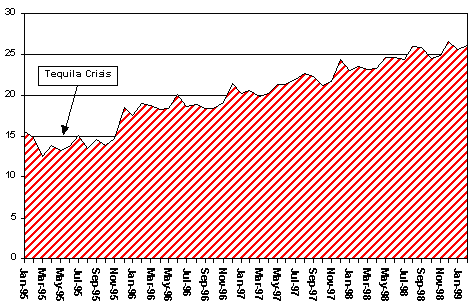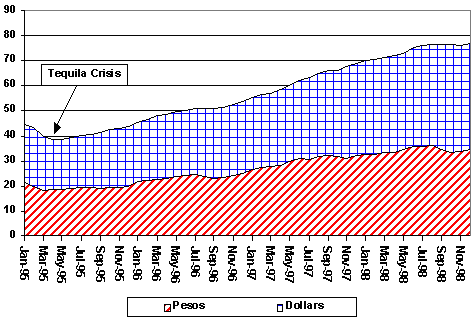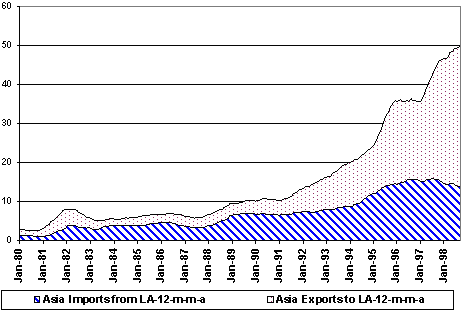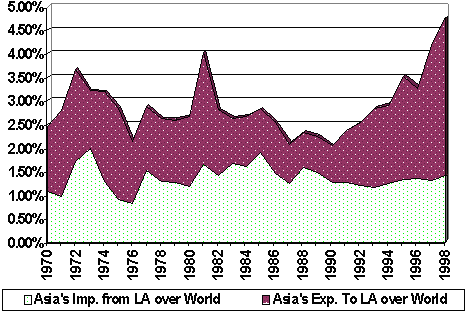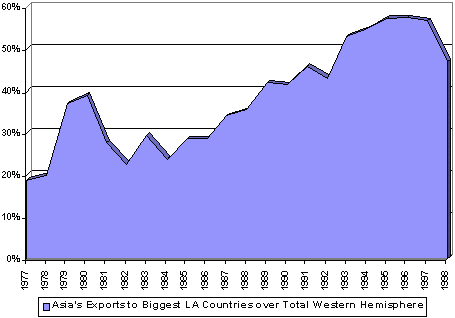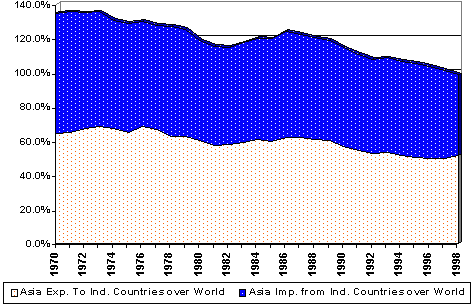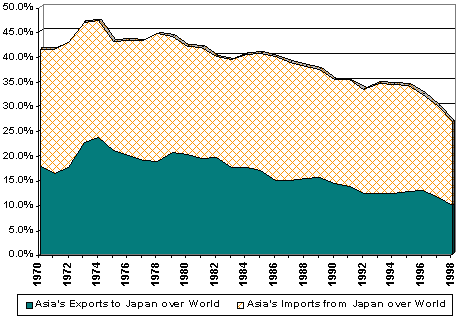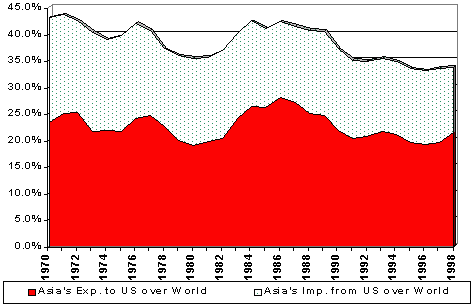|
Impact on the Asian Economy and Prospect Eugenio J. Alemán
Brazil: The Devaluation of the Real
On January 15, the Brazilian real succumbed to a currency attack. The attack began in September of last year when the effects of the Russian debt default took center stage in the biggest economy of South America. The Brazilian abandonment of its exchange rate regime has a strong resemblance with the Mexican response in 1994 and 1995. However, Mexico in 1995, as well as Thailand in 1997 and Russia in 1998 had nearly depleted its reserves. Brazil, on the other hand, had an IMF package totaling $41.5 billion. Of the total loan package, the government could draw as much as $33 billion over the next twelve months. The total amount of reserves at the time of devaluation, including $8 billion from the IMF package, was around $40 billion, worth nearly 8 months of imports. After the devaluation, the fiscal imbalance will persist
The devaluation does not solve the core of Brazilian problems. The federal debt was R$320 billion in November. We could usually expect the real-denominated debt, in dollar terms, to diminish with a devaluation of the domestic currency. However, the bulk of the debt is indexed to the dollar or at a floating interest rate. As of November of 1998, 21% of the federal debt was indexed to the US dollar and 64% to the overnight interest rate.
The Brazilian government and domestic investors will face risk premiums that are likely to escalate as the situation of the real remains unsettled. Coupled with this, the privatization process, one of the high points of the Cardoso administration in 1998, could have setbacks as long-term investors shun the Brazilian market. The Brazilian government is hoping for at least $15 billion in receipts to come from the sale of the power generation units and remaining banks. This is critical to financing the current account deficit in 1999, which is likely to remain around 3% of GDP. Brazil's GDP is expected to contract by 4% in 1999. On the inflation front, we see a moderate pass-through from depreciation to inflation, if the exchange rate settles at around R$ 1.90 with an average inflation rate of 15%. This estimate assumes an orderly retrenchment of interest rates to 25% at year-end and the stoppage of outflows of capital in the near future. Argentina: Recession in 1999, currency board and 1-to-1 peg to the dollar is maintained
Argentina will be one of the hardest hit economies of the region after Brazil. There are two reasons for this. First, capital will flow out of the country producing a decrease in money supply. Second, banks will contribute to this decrease in money supply as they begin to tighten credit to the domestic market. These two effects are expected to affect interest rates, which in turn will produce a slowdown in economic activity. The Currency Board
The currency board and the peg of the Argentinean peso, on a one-to-one relationship with the dollar, will be maintained. In case there is any chance that the currency board and the peg are at risk _ through a drainage to foreign reserves _ the government will fully dollarize the economy. With today's inflation rates in the United States, the only drawbacks of this dollarization process will be the loss of seignorage (the revenue the government gets from printing money). At the end, it will be a very low price to pay for stability and confidence.
Monthly (Billion of US dollars)
Source: BCRA, February data is until February 21, 1999
The banking system, once the weak link for Argentina's economy and currency board system, has seen an enormous transformation and strengthening since the 1995 crisis. In the midst of the Tequila crisis, Argentina's banking system lost almost 20% of its deposits. However, the Asian crisis and the Russian default have proved the strength of the banking system. Today, more than 50% of the banks are owned by foreign banks which compares positively with 15% before the Mexican crisis.
(Pesos and US dollars, Billion)
Source: Broda & Asociados, February data is until February 21,1999
We have to distinguish two effects for 1999's GDP behavior in Argentina. The first one is the trade-effect and the second one is the monetary-effect. We estimate that a devaluation in Brazil will produce a 1% decrease in Argentina's GDP. However, this effect is just a trade-effect. We have to include the effects of capital outflows and tightening of credit by the banking system, which will reduce money supply, increase interests rates, and decrease investment, consumption, and credit. This later effect, which is the monetary-effect, will impact Argentina's GDP by -1% to -3% for 1999, depending on the severity of the money supply contraction. The actual effect will depend on how deep the capital flow and the credit crunch is, with a risk on the downside. From our latest forecast we had Argentina's GDP growing by 2.1% during 1999, so the total impact of the devaluation in Brazil will take GDP growth for 1999 to -1.5%. If the Brazilian devaluation, however, continues to spread to the rest of the world, with a further weakening of world demand and commodity prices, then we should expect a bigger impact over the Argentine economy as this place further pressures over exports growth. Although Argentina's exports as a percent of GDP are very low (8-9%), the Mercosur agreement has added to the dynamism of the Argentine economy since the beginning of the decade. In the longer term, the effect of the Brazilian devaluation on Argentina's GDP prospects will depend on the devaluation of the real and in the country's ability to shift exports to other markets. This later issue is by no means easy to solve as it will need higher investment and higher efficiency in production. At the same time, this goes hand in hand with foreign investor's sentiment on the future of Mercosur and the role Argentina plays within this trade block. Mexico: Riding on the right horse
Mexico's economy will suffer a contagion effect from the devaluation of the Brazilian real as capital leaves the country and interest rates increase in the short and medium-term. However, Mexico's economy is riding on top of the US economy as the US remains Mexico's biggest trading partner. At the same time the NAFTA agreement will shield Mexico's potential trade effects from the Brazilian crisis. WEFA expects Mexico's GDP to hover around 3% during 1999. However, the maintenance of high interest rates in the face of continued scare over the Brazilian situation puts the risks of Mexican GDP growth for 1999 on the downside. At the same time, bad memories concerning the Mexican Tequila crisis will probably contribute to a continued pressure over its currency on the foreign exchange markets. Chile: When it rains it pours!
First it was the Asian crisis, hitting exports to the Asian countries, Chile's main trading partners. Then, the price of Chile's main commodity export, copper, which is at an all time low, decreased, further affecting its exports performance, which is the backbone of Chile's celebrated export oriented economy. Now, Chile has to deal with the Brazilian crisis and the devaluation of its currency, which will put further pressure to its once celebrated performance. Furthermore, after the creation of Mercosur, Chile's businesses and investments have shifted towards the regional trade agreement, and more specifically towards Argentina and Brazil. Now that the Argentine and Brazilian economies are heading into recession, the Chilean economy needs help from commodity prices, and the Asian countries, to minimize the effects of the regional recession. Although we do not expect Chile to face a recession during 1999, we expect a further slowdown in its economy, which could take GDP growth for 1999 to 2%. Impact on the Asian Economy: Would there be any?
Brazil's recent move to a flexible exchange rate and the subsequent sharp depreciation of its currency is likely to have a minimal impact on Asia in the short-term. However, the long-term picture is less sanguine. Direct economic linkages between Asia and Latin America are weak, but indirect linkages, particularly those through the US economy could be significant. Brazil's economy accounts for 42% of Latin America's GDP; Latin America receives 20% of US exports; and, the US receives 20% of Asia's exports. A slowdown in Latin America could spill over into Asia via a dampening of US growth. Moreover, currency devaluation in Latin America will mean increased competition for Asian goods in third markets, particularly steel and coffee.
The worsening of sentiment in general towards emerging markets also poses some risk to Asia. A widening of spreads on sovereign issues will make it more expensive to raise capital, and could affect the fiscal plans of Asian governments. A slightly smaller risk comes from the increased pressure on Hong Kong's currency board and the Chinese renminbi. That risk could become significant, however, if - contrary to current expectations - the Argentine peg collapsed. There are three possible effects for the Asian economies, two indirect effects and one direct effect. Direct (Real) Effect The first effect will be the one related to the direct trade linkages between Asia and Latin America. Even though these trade linkages are very small, compared to Asia's trade with the rest of the world, the reality is that Asia's exports to the Latin American region has been growing constantly since the early 1990's. The following figure shows total trade between Asia and Latin America or, more precisely between Asia and the Western Hemisphere as it is defined by the IMF on their Directional Trade Statistics. Here we have exports and imports to and from Asia to Latin America in billions of dollars.
Billions of dollars, 12 months-moving-average
Source: IMF DOT and WEFA estimates
as a % of total trade with the World
Source: IMF DOT and WEFA estimates
Percentage over Total Exports to the Region
Furthermore, Asia's exports to the Latin America region, although small in relative terms, have been one of the only bright spots of Asia's overall exports. In fact, Asia's exports to the Latin American region are probably one of the only one growing as a percentage of Asia's total world exports. The following figures paint a good picture of this.
over Total Exports to the World
Source: IMF DOT and WEFA estimates
Source: IMF DOT and WEFA estimates
Source: IMF DOT and WEFA estimates
The first indirect effect is through a decrease in US exports to the Latin American region. The effects of a slowdown in growth in Latin America will hurt US exports and profits as private consumption will be hard hit. Not only the volume of exports will decrease but profits accruing to the businesses operating in these markets will also decrease. These markets are far from being competitive, which means that unit profit margins are higher than those found in other more competitive markets. Due to price rigidities through highly oligopolistic markets, foreign firms doing business in the Latin American countries enjoy a very high unit profit margin. The effect will not be a decrease in these unit profit margins but rather a decrease in the number of units sold, hurting overall profits accruing to firms in the US and elsewhere. The actual effect is very difficult to estimate, however, with downward pressure on prices all over the world and very low unit profit margins in the developed countries, the effect will be on firm's overall profits during 1999. The negative profit effect on US firms doing business in the Latin American region could affect the valuation of firm's stocks in Wall Street, potentially bursting the so called "equity price bubble." Indirect (Devaluation) Effect There is one potential disruption to Asia's trade with the US as well as with the Latin American region. This disruption has to do with the short-run increased competitiveness of Brazilian products in world markets, just as it was the case with the Asian countries devaluation in late 1997. However, much of this "invasion" of Brazilian products will depend on the availability of financing to Brazilian firms and the policies implemented by the different governments to minimize those effects. What is more important here is the effect that a further weakening in world demand coming from the Latin American region will have over commodity and non-commodity goods prices in general as well as to the overall oversupply of goods. One of the most affected industries in Latin America will be the automobile industry, as its production is highly dependent on the Mercosur countries and it is not competitive in world markets. In order for a devaluation to be beneficial, countries devaluing their currencies need increased demand from the rest of the world. However, today's world growth prospects are far from those needed for a devaluation to be effective. Furthermore, there is always the threat of a spiral of competitive devaluations that could make things worst in world markets. The worst possible scenario would be the potential of China's devaluation. This would send shock-waves across the world with other Asian countries answering with further devaluations to catch-up with China. Another potential blow for the Asian and world economy is the potential of Argentina and Hong Kong to be pushed towards abandoning their peg to the US dollar. We are optimistic that this will not happen in the case of Argentina as the government will fully dollarize the economy in the event there is a threat to its peg. However, the risk will always be present and the unresolved Brazilian crisis will continue to affect capital flows to the region, slowing growth even further. Conclusion What is a stake here is the sustainability of a growth model based excessively on ever increasing exports and high-investment to achieve economies of scale. In the US, which is a relatively closed economy, exports are a complement to growth, rather than its main growth strategy. Internal demand drives most growth in the US. The Asian countries, including Japan, suffer from excessive investment and are unable to use internal demand to improve their economies when exports fall. On the other hand, the Latin American countries are highly dependent on internal demand and foreign capital inflows to grow and to finance high consumption levels. However, their export orientation is highly dependent on commodities with very low value added. This puts further pressure on increasing exports volumes, which at the same time induces further downward pressure on commodity prices. In summary, the Latin American woes will hurt Asian countries:
Copyright (c) 1999, WEFA
|
